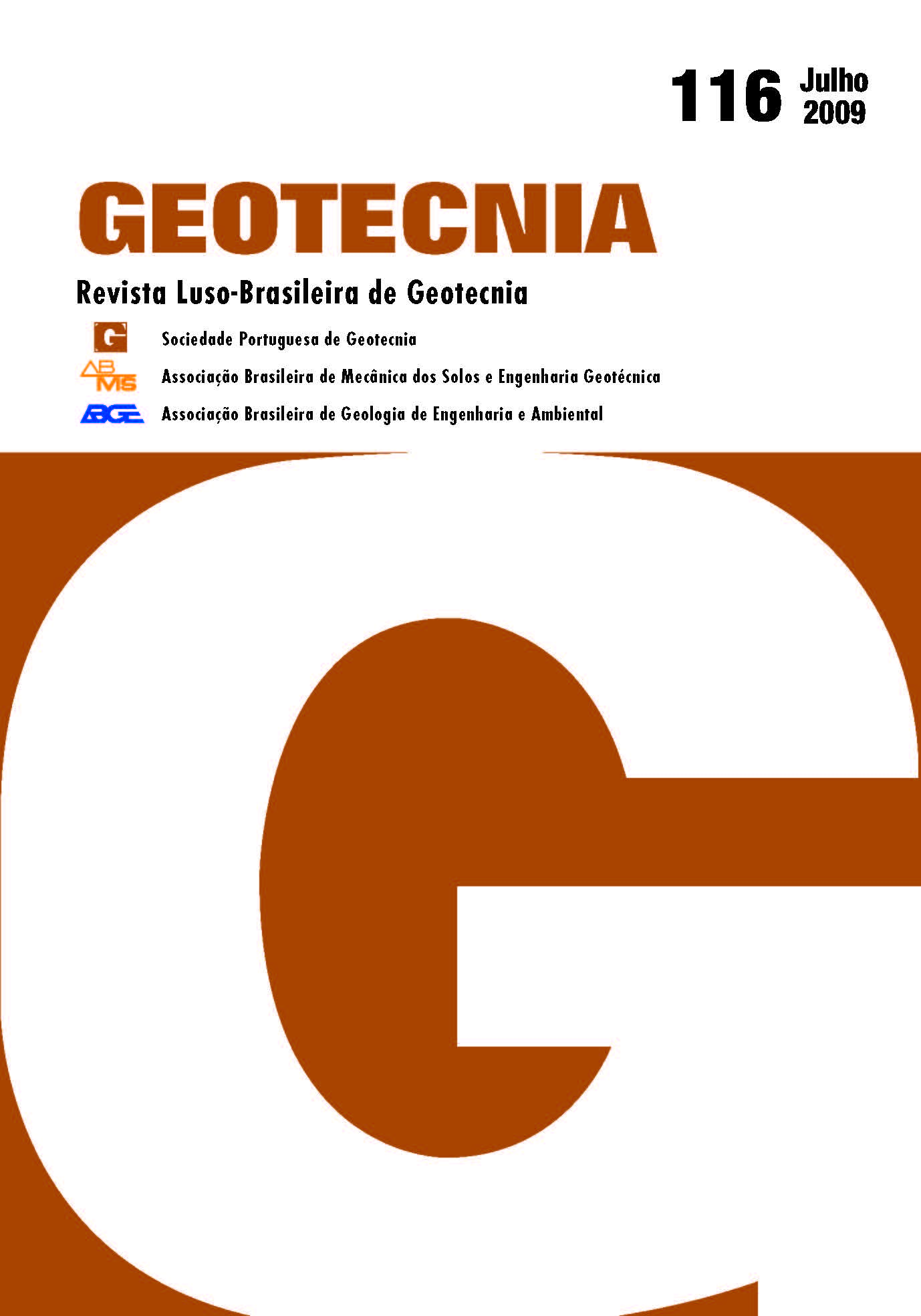Alguns resultados de ensaios De fluência e rotura em fluência à tracção de geossintéticos
DOI:
https://doi.org/10.14195/2184-8394_116_3Palabras clave:
Durabilidade, fluência, rotura em fluência, comportamento a longo prazo de geossintéticosResumen
Descreve-se um equipamento desenvolvido para a realização de ensaios laboratoriais de fluência e de rotura em fluência à tracção de geossintéticos. Estes ensaios permitem estudar o comportamento me câ ni - co em tracção de longo prazo dos geossintéticos. Começa-se por apresentar os conceitos de fluência e de rotura em fluência, em que se baseia a definição dos procedimentos de ensaio. É feita a referência normativa cor - respon dente. Para além do equipamento desenvolvido, são descritas as metodologias de ensaio e são apre sen - ta dos alguns resultados iniciais obtidos através deste ensaio. A campanha de ensaios incluiu dois geos sin té ti - cos com estruturas diferentes. São apresentados os valores para os coeficientes de segurança parciais deter mi - na dos a partir dos resultados dos ensaios. Referem-se ainda as principais conclusões deste estudo.
Descargas
Citas
EN ISO 13431 (1999). “Geotextiles and geotextile-related products – Determination of tensile creep and tensile creep rupture behaviour”.
ISO 554 (1976). “Standard Atmospheres for Conditioning and/or Testing – Specifications”. NP EN ISO 10319 (2006). “Geotêxteis – Ensaio de tracção em tiras largas”.
Allen, T. M. e Bathurst, R. J., (1996). “Combined allowable strength reduction factor for geosyn - thetic creep and installation damage”, Geosynthetics International, Vol. 3, No 3, pp. 407-439.
Crawford, R. J. (1998). “Plastics Engineering”, Butterworth-Heinemann, Oxford, 3ª edição, p. 505.
Greenwood, J. H. e Friday, A. (2003). “Seminar on Predicting a 100 year lifetime for Geosyn the - tics”, Proceedings of the seminar, ERA Technology, Leatherhead, Surrey, UK.
Holtz, R. D., Christopher, B. R. e Berg, R. R. (1998). “Geosynthetic design and construction guidelines”, National Highway Institute, Federal Highway Administration, U.S. Department of Transportation, Washington, D. C., report FHWA-HI-95-038, revisto em 1998, p. 394.
Kay, D., Blond, E. e Mlynarek, J. (2004). “Geosynthetics durability: a polymer chemistry issue”, 57th Canadian Geotechnical Congress, GeoQuébec 2004, Session 4D, pp.1-14.
Lopes, M. L. (1992). “Muros reforçados com geossintéticos” Dissertação de Doutoramento em Engenharia Civil, F.E.U.P., Porto.
Miller, E. (1996). “Introduction to plastics and composites”, ed. Marcel Dekker, Inc, New York, USA, p. 434.
Müller-Rochholz, J. (1997). “Practicalities of measurement of creep and stress-rupture”, Seminar volume on c reep and assessment of geosynthetics, December 1997, ERA Technology, Leatherhead, U.K., pp. 1.1-1.12.
Müller-Rochholz, J. e Koslowski, C. (1996). “Creep prediction”, Proceedings of the 1st European Conference on Geosynthetics, EuroGeo1, Maastricht, The Netherlands, pp. 1027-1030.
Pinho-Lopes, M., Lopes, M. L. (2003). “Um Equipamento para Realização de Ensaios Labora to - riais de Danificação durante a Instalação de Geossintéticos“, Revista Geotecnia, Julho de 2003, nº 98, pp. 7-24.
Pinho-Lopes, M.J.F. (2006). “Estudo dos coeficientes de segurança a aplicar a estruturas de con tro lo de erosão de solos e de estabilização de maciços com geossintéticos“, Dissertação de Doutoramento em Engenharia Civil, F.E.U.P., Porto.
Rolin, A. (2004). “Long term performance of geotextiles”, 57th Canadian Geotechnical Congress, GeoQuébec 2004, Session 4D, pp.15-20.
Sawicki, A. (2000). “Mechanics of reinforced soil”, A.A. Balkema Publishers, Rotterdam, Netherlands, p. 195.




